| Tan An - Ben The Temple | Historical - Culture Monuments | Bài viết | | Tan An - Ben The Temple | /dautuphattrien/PublishingImages/2017-06/dinhbenthe3 ava-1401333703_Key_27062017161156.jpg | Tan An - Ben The Temple is located in quarter 1, Tan An Ward, Thu Dau Mot City. This is a province-level historical cultural monument that was recognized on Jun 2nd 2004. | 1/1/2017 5:00 PM | No | Đã ban hành | | On Apr 26th 2014 Tan An Temple was recognized as nation-level architectural monument by the Ministry of Culture, Sports and Tourism according to Decision No. 1261/QD-BVHTTDL. Those, who came to Tan An - Ben The, were definitely attached to a romantic image of an ancient gate and a hundred-year-old banyan tree with big roots entwining the old gate. This image was selected as the main scene context of the ancient southern village by Vietnamese filmmakers. Tan An Temple was built in 1820 to worship Tien Quan Co Nguyen Van Thanh, who was one of the closest advisors of Nguyen dynasty. Entering the temple, there is firstly a forest of precious woods, such as go, sao, cam, dau… Therefore, this is also an ideal place for outdoor activities in the summer. Passing the forest, we see a three-arched-entrance gate leading into the house. Many Han-script lacquered boards, scrolls, parallel sentences are hung on columns and altars, these are very useful and valuable for cultural studies. Altars, statues are well-engraved works showing excellent skills of artisans at that time. Currently, the temple preserves "Sac phong" conferred by Tu Duc King in 1853. In addition to historical and cultural values, Tan An Temple is a meeting place for cultural activities of local people, especially on full moon day of annual lunar November. Every three years, there is a big festival with performances of classical theater. Address: Quarter 1, Tan An Ward, Thu Dau Mot City | | Phu Cuong Temple | Historical - Culture Monuments | Bài viết | | Phu Cuong Temple | /dautuphattrien/PublishingImages/2017-06/dinh-than-phu-cuong ava-1401333862_Key_27062017161926.jpg | Phu Cuong Temple is located in Phu Tho Ward, Thu Dau Mot City, is a province-level historical cultural monument that was recognized on Jun 2nd 2004. | 1/1/2017 5:00 PM | No | Đã ban hành | | Phu Cuong Temple, which is also called as Ba Lua Temple, was built in the second half of the 19th century, is well known for its size and unique architecture. The sanctum was on a high foundation, has a traditional architecture with three spaces. The innermost space of Sanctum is called "Chanh tam" or "Hau cung" to worship "Thanh Hoang" God. Both sides are also worship mosaics. An incense table is placed in front of the god's altar. The main space has some horizontal lacquered boards and paralell sentences to make a dignified place of worship. The center space is for pre-worship rituals, like displaying offerings, reading funeral orations… The outermost space is called "Hoi dong ngoai" with small temples of "Tien hien" and "Hau hien". Both sides of Sanctum has "Dong lang" for all people to meet and a warehouse. The front yard has dragon tiger scenes and Shen Nong's altar. Both sides are for worshiping left and right protector. This place also keeps a lot of antique weapons, rare and beautiful furniture. The temple has annually two sacrifice periods: Ky Yen Festival (full moon of lunar January) and Thu Te Festival (1st day of lunar October) attract the participation of many tourists. 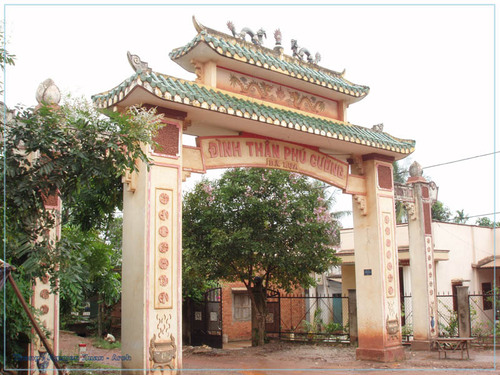
| | Phuoc Thanh Province Governor’s Palace | Historical - Culture Monuments | Bài viết | | Phuoc Thanh Province Governor’s Palace | /dautuphattrien/PublishingImages/2017-06/Nha truyen thong_Key_27062017162335.jpg | Phuoc Thanh Province Governor’s Palace is located in quarter 2, Phuoc Vinh town, Phu Giao district. This is a province-level historical monument that was recognized on 9th Jul 2004. | 1/1/2017 5:00 PM | No | Đã ban hành | | In Ngo Dinh Diem reign, Phuoc Thanh province was established as a strong zone, along with Chon Thanh, Binh Long, Dong Xoai, Loc Ninh, Phuoc Long, to form a joint military powerbase separating D War Zone from Duong Minh Chau War Zone and Southern Highlands and hindering aids from northern rear to the southern battlefield. On 17th Sep 1961, C80 soldiers simultaneously attacked the Governor Palace and dissolved completely the enemy force, occupied this palace. Governor Nguyen Minh Man was destroyed on the spot. This victory opened a new turning point to southern revolution force, from being passive on the battlefield switching to proactive position, frustrating any US conspiracies, contributing to the historic victory on 30th Apr 1975, the liberation of the South and national reunification. Currently, Phuoc Thanh Province Governor's Palace is a traditional house of the district for introducing the resilient fighting spirit of our army and people to domestic and foreign tourists. | | Rubber plantation under French domination | Historical - Culture Monuments | Bài viết | | Rubber plantation under French domination | /dautuphattrien/PublishingImages/2017-06/anh-12-460x306_Key_27062017162718.jpg | Rubber plantation under French domination is located in Lot 50, Village 14, Tran Van Luu farm, Dinh Hiep commune, Dau Tieng district. This is a province-level historical monument that was recognized on 1st Apr 2009. | 1/1/2017 5:00 PM | No | Đã ban hành | | After nearly one century, rubber lot 50 of Village 14, Tran Van Luu farm under Dau Tieng Rubber Company is verdant, although on tree trunks retain knife cuts of rubber workers from French colonial period. This place also marked the first plantations established by French colonial in our country in the early twentieth century. Rubber workers combated severe and cruel bosses, managers from French domination period to the resistance war against the US and won the national independence on 30th Apr 1975. People in Dau Tieng district never forgets the miserable life of rubber workers under French domination period. Therefore, on 12th Oct 2010, Dau Tieng Rubber Company started the construction of exhibition area of Historical monument Rubber plantation under French domination at Dau Tieng peace on earth today, referring to the investigation life wife, Dau Tieng people, especially those who had been the wife of the investigation and their children an unforgettable life miserable wife under French colonial rule. Therefore, on 12/10/2010, the Company Limited Dau Tieng Rubber has started construction of exhibition areas Historic Park under the French rubber in block 50, Village 14, Dinh Hiep commune, Dau Tieng district. This is the oldest rubber batch of systems under the French rubber. Exhibition area consists of 3 parts: The display of relics and pictures of rubber under the French village, the wife of the French investigation and rulers. The building has great significance in terms of history, is evidence of a period of history and is home to many events mark the history of the nation, showing the development of the movement of workers in plantations rubber. | | Ho Nam eco-tourism zone | Ecotourism | Bài viết | | Ho Nam eco-tourism zone | /dautuphattrien/PublishingImages/2017-06/1-1401092910_Key_27062017163723.jpg | Ho Nam ecotourism zone is located in Phuoc Thai quarter, Thai Hoa ward, Tan Uyen Town, is 10km away from Binh Duong New City center. | 1/1/2017 5:00 PM | No | Đã ban hành | | Ho Nam ecotourism zone was built in Nov 2011 on an area of 15ha. The highlight of the resort is pine houses in a very cool fresh air. Tourists may enjoy relaxing moments while strolling under big trees on lakesides with services, such as: floating restaurant, fishing, swimming pool, garden cafe, kid zone, water games and many other exciting games. In addition, Ho Nam ecotourism zone is also a destination for young persons' get-togethers, festivals and camping. This is also an ideal place for couples to take wedding photos to preserve their precious memories. Regarding dining, Ho Nam serves Asian, European dishes, and especially Vietnamese cuisine. Ho Nam ecotourism zone with rustic, idyllic scenery in modern style will definitely please guests coming here. | | Lo lu Dai Hung (Dai Hung clay-jar kiln) | Historical - Culture Monuments | Bài viết | | Lo lu Dai Hung (Dai Hung clay-jar kiln) | /dautuphattrien/PublishingImages/2017-06/llll_Key_27062017160407.jpg | Lo lu Dai Hung is located at quarter 1, Tuong Binh Hiep ward, Thu Dau Mot City, about 3 km away from Thu Dau Mot center toward the north, was recognized as province-level cultural monument on Oct 30th 2006. | 1/1/2017 4:00 PM | No | Đã ban hành | | The name "Lo lu" originated from pottery kiln specializing in producing all kinds of jars, pots… for agriculture, fisheries and ancient life. Lo lu Dai Hung is the oldest pottery kiln in Binh Duong, currently retains the traditional production method with typical handcrafted products. Lo lu Dai Hung is over 150 years old, its founder is a Chinese in the 17th – 18th century. Lo lu Dai Hung has experienced many ups and downs. At the most difficult moment, Lo lu Dai Hung seemed to be closed. Time went by, along with historical and life changes, Lo lu Dai Hung retains its traditional handcrafted production method and without machines, while other pottery producers in Binh Duong have changed and implemented mechanization. This is the standpoint of the current owner Tam Giang as well as provincial Department of Culture - Sports and Tourism to preserve the tradition. Pottery is a special traditional craft, a feature of Binh Duong province. Lo lu Dai Hung is a representative, pride, an identity of this land, and also leaves an important trace on the path of traditional craft development of Thu Dau Mot - Binh Duong. Address: Tuong Binh Hiep Ward, Thu Dau Mot City, Binh Duong | | Tran Cong Vang’s Ancient House | Historical - Culture Monuments | Bài viết | | Tran Cong Vang’s Ancient House | /dautuphattrien/PublishingImages/2017-07/trần công vàng 5-1411441908-1466498279_Key_03072017150649.jpg | Tran Cong Vang’s Ancient House is located at No. 21, Ngo Tung Chau Street, Phu Cuong Ward, Thu Dau Mot City, is a National Artistic Architecture Monument ranked on January 7th,1993. | 1/1/2017 4:00 PM | No | Đã ban hành | | Built in the architectural style of opposite letter Dinh in Chinese language (丁) on the area of 1,333m2, the dentist Tran Cong Vang's house turned south, behind the hill. According to feng-shui, this is is considered as a favorable position. Like the ancient house of Tran Van Ho, Tran Cong Vang's ancient house is most noticeable visitors due to sophisticated meticulous carvings. From the plinth to the roof, tables, chairs, cabinets, church site, door frame, cage box, horizontal, sentences scrolls, couplets, paintings quarter-bottle... carved, painted and carefully nacre skillful, respect the magnificence appearance and dignified of the house. 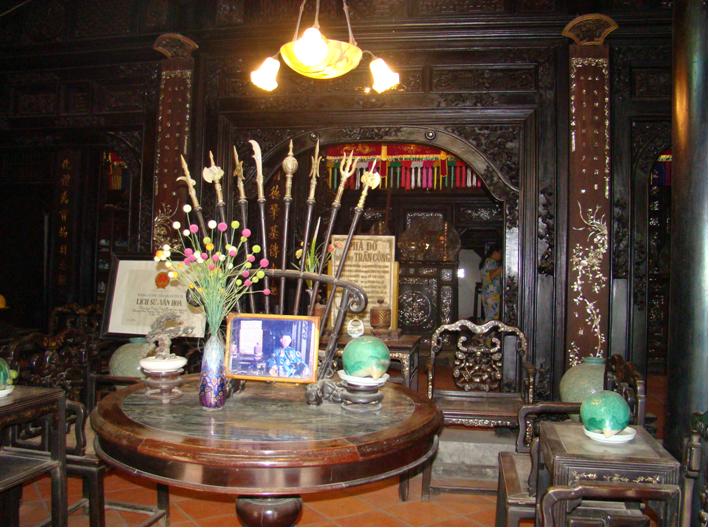
| | Tran Van Ho's ancient house | Historical - Culture Monuments | Bài viết | | Tran Van Ho's ancient house | /dautuphattrien/PublishingImages/2017-07/Tran van Ho 2-1401154165_Key_03072017150918.jpg | Tran Van Ho's ancient house is located at no. 18, Bach Dang street, Phu Cuong ward, Thu Dau Mot city, is a National Artistic Architecture Monument ranked on January 7th 1993. | 1/1/2017 4:00 PM | No | Đã ban hành | | Walking along the romantic Saigon River near the Thu Dau Mot market area, visitors will meet a dignified ancient architecture in the architectural style of letter Dinh in Chinese language (丁) of Southern style, which is the ancient house of Tran Van Ho. Mr. Tran Van Ho (also called Dau) is a former French colonial Governor under French. His ancient house was built in the year of the Tiger (1890), on an area of 1.296m2. The significant highlight of the house is the inside material of precious wood such as: rose- wood, Narra Padauk, red- wood, Lauan meranti, sindoer… are arranged proportionately on each detail, creating a dignified appearance, showing the style of kingship. Today, visitors to Binh Duong, besides visiting modern amusement park, also spend time to enjoy ancient architecture buildings with special cultural and historical architectural value.
| | Chau Thoi Mountain Pagoda | Historical - Culture Monuments | Bài viết | | Chau Thoi Mountain Pagoda | /dautuphattrien/PublishingImages/2017-07/Sotaydulich_Doc_mien_dat_nuoc_Van_canh_chua_Nui_Chau_Thoi_04_Key_03072017151128.jpg | Chau Thoi Mountain Pagoda is located in Binh An Ward, Di An Town, which is a national-level scenic monument recognized on April 21st, 1989. | 1/1/2017 4:00 PM | No | Đã ban hành | | Chau Thoi Mountain heritage has 82m high, 25ha wide in the delta near the residential areas of the provinces and cities: Binh Duong, Dong Nai, Ho Chi Minh City, convenient location for sightseeing as it is close to landscapes, entertainment areas such as Tam Bao Pagoda, Lo su stream, Buu Long Mountain. Chau Thoi Son Tu - one of the oldest pagodas in Binh Duong and the South East, be preserved, embellished and developed to this day. The pagoda was built with fine architecture and monumental including: Main Hall, the Patriarchate, Thien Thu Thien Nhan hall, Linh Son Thanh Mau temple, Dieu Tri Kim Mau va Ngu Hanh Nuong Nuong hall. The highlight of the temple architecture is to use ceramic pieces to decorate, create a dragon phoenix and embellish paintings depict the story of Buddhism is very elaborate and beautiful... Not only with fine architecture, Chau Thoi Mountain Pagoda is also beautiful scenery, surrounded by ancient woods and clear blue water, so it is very quiet. Visiting the pagoda, visitors walk on 220 steps of mossy terraces of the time, will feel the peace, tranquility of Buddha in an immense, airy and romantic space.
| | Incense making career | Traditional Villages | Bài viết | | Incense making career | /dautuphattrien/PublishingImages/2017-06/nhang-1409193526_Key_27062017104841_Key_29062017140056.jpg | Village of incense in Di An Town is one of the handicraft villages of more than 100 years of age in the humble existence within a jubilantly industrialized town. | 1/1/2017 3:00 PM | No | Đã ban hành | | Before becoming a town of strong industrialization, Di An had long been famous for handicraft villages. Incense production is still of high economic yields; however, fewer is producing incense now. Incense production establishment was unknown but it has been with local generations. Their products have been famous nationwide and even in foreign markets. In its golden time, day and night production of incense was well noted. The materials required well-grown bamboo from Bu Dop of Phuoc Long in Binh Phuoc Province or from Nam Cat Tien of Lam Dong. Incense craftmen are adorable for their skills of selecting bamboo and dividing bamboo into sticks of exact sizes. Currently, over 50 families in Di An Town are following the incense production with average income of VND 4-5 million a month for a worker. Incense production can be all year round but shall be at the peak in a few months before Tet Holiday as the demands for incense increases. Materials for incense making includes bamboo and dust of trees, wood, and scents in good mixture for easy burning, sweet scents, and lasting. As the matter of fact, the preparation of materials is of the most importance to ensure good shaping of the incense by the good skills of the craftmen. The preservation and development of Di An incense village have been taken good care of by Binh Duong Province. Producing households are offered loans from the province for production. Besides, Binh Duong Province has been making efforts of marketing the incense products through exhibition fairs and product introduction. | | Clay piggy bank crafting | Traditional Villages | Bài viết | | Clay piggy bank crafting | /dautuphattrien/PublishingImages/2017-06/532-9-1411457730_Key_27062017105056_Key_29062017141054.JPG | Clay piggy crafting in Lai Thieu of Thuan An Town was originated for over half a century. Up to date, although the number of families following this line of production has been lower, the traditional trait of the craft villages remains. Those families staying with the production line are still diligent with the production of clay piggy bank. | 1/1/2017 3:00 PM | No | Đã ban hành | | The paint scent occupies the atmosphere upon our visit to the handcraft village. Getting further inside, the colorful clay piggy banks overwhelm our vision. The production is in specific areas (villages) but many have switched to other career, making up only 30 producing households scattering around. To compete with plastic products, the craftmen create various kinds of piggy banks in all shapes of duck, golden fish, Doraemon, swan, dove, etc. The products of those villages are for domestic and exportation markets. Address: Hoa Long Quarter, Lai Thieu Ward, Thuan An Town. | | Wood sculpture | Traditional Villages | Bài viết | | Wood sculpture | /dautuphattrien/PublishingImages/2017-06/LN_02cham khac go truyen thong_Key_27062017105447_Key_29062017141252.jpg | Wood sculpture is of long-term tradition of over 200 years of existence and transited from generations to generations. | 1/1/2017 3:00 PM | No | Đã ban hành | | Thu Dau Mot used to be the cradle of domestic woodwork in Southern Region of the nation where vast woods and precious woods reside. This is also the land of excellent craftmen and wood sculpture. Currently, at Phu Tho Ward of Thu Dau Mot City exists the sculpture village of Phu Tho and wooden slipper village of Phu Van. Domestic furniture of Thu Dau Mot has been famous wide and far thanks to good and eye-catching styles. Binh Duong sculptures know much about decorative patterns of elegant features. By skillful work, creativity, and experience of sculpturing on various materials and product types of chairs, panels, parallel sentences on wooden panels, etc. the craftmen have created products of public tastes across localities from Binh Duong Province. | | Lacquer | Traditional Villages | Bài viết | | Lacquer | /dautuphattrien/PublishingImages/2017-06/Tranh Son mai dong que_3_Key_27062017105806_Key_29062017141454.jpg | Tuong Binh Hiep lacquer village is still the pride of locals for many centuries. This is considered as the cradle of the local lacquer industry. | 1/1/2017 3:00 PM | No | Đã ban hành | | Going along Highway 13 of northern, through Suoi Giua toll station and then turning left to Ho Van Cong street, tourists will see a big board with words "Tuong Binh Hiep lacquer village". Going deep into the village, they will come across booths with a wide range of lacquer products from tables, chairs, beds to pictures, flower pots, jewelry boxes...With artists' clever hands, these products become valuable with sophisticated and smooth features. Tuong Binh Hiep lacquer village is still the pride of locals for many centuries. This is considered as the cradle of the local lacquer industry and was recognized as a traditional craft village by provincial People's Committee. Coming to the village, tourists will have a chance to learn about each stage of this unique traditional craft that only exists in Vietnam, select and purchase the most satisfactory products for their families and friends. | | Bamboo and rattan weaving craft | Traditional Villages | Bài viết | | Bamboo and rattan weaving craft | /dautuphattrien/PublishingImages/2017-06/20121009-24_Key_27062017110439_Key_29062017141647.jpg | With long and vigorous development, bamboo and rattan weaving craft in Tan Uyen town has contributed to enriching Binh Duong land's fine art and handcraft items. | 1/1/2017 3:00 PM | No | Đã ban hành | | Being not only beautiful, durable and environmentally friendly, bamboo and rattan items also bear the cultural value of traditional craft villages. With exquisite talent, artists generate unique-but-simple items from natural materials like bamboo, rattan... There is a diversification in design and pattern for bamboo and rattan items, ranging from flower baskets, tables, chairs, decorative lamps to souvenir gifts. They are not only used as home decorative products, but also present at restaurants, hotels and luxurious coffee shops. Their quality is also improved at market's demand and customers' taste. Currently, Binh Duong's bamboo and rattan items are present nationwide and exported into countries around the world. | | Pottery | Traditional Villages | Bài viết | | Pottery | /dautuphattrien/PublishingImages/2017-06/images669564_Anh_1_Key_27062017110110_Key_29062017141813.jpg | Thu Dau Mot land in Binh Duong Province is famous for various handicraft villages, especially, pottery including Chanh Nghia, Lai Thieu, Tan Phuoc Khanh, and so on. Products of Minh Long have been favored by domestic and foreign buyers in Vietnam and abroad. | 1/1/2017 3:00 PM | No | Đã ban hành | | Minh Long products are diversified with over 15,000 types and models of traditional and modern styles. Decorations on the products are simple and close to Vietnamese culture of bamboo bushes, the stork flying in the sky, the buffalo watching boy blowing the flute, the villages of the North, the waterways of Mekong Delta, cultural and historical remains, beauty locations of the nation, etc. Those images touch the heart of every Vietnamese looking back to their origin. Minh Long pottery products also include people's ethics and cultures in group of products, expressing oriental philosophy in sophisticate products attracting the vast tourists. | | Lai Thieu orchards | Ecotourism | Bài viết | | Lai Thieu orchards | /dautuphattrien/PublishingImages/2017-06/dulich1_Key_31122016152749_Key_29062017142659.JPG | Lai Thieu Orchard has been famous as a characteristic agro-ecological zone of Binh Duong province and the South East region, a "Holy Land" of fresh fruits. | 1/1/2017 3:00 PM | No | Đã ban hành | | Every year, from Mar to the end of May (lunar calendar), tourists from everywhere flock to Lai Thieu for a picnic at lush orchards full of sweet fruit-laden branches located along Saigon River. Lai Thieu orchards has a total area of 1,200 ha in 6 communes, Vinh Phu, Lai Thieu, Binh Nham, Hung Dinh, An Thanh, An Son. This is the oldest fruit-growing area (approximately 200 years old) with various famous specialty and most delicious fruits of the Southeastern region, such as durian, sweetmeats, cempedak, especially Lai Thieu mangosteen. Some attractions, dining places at Lai Thieu orchards 1. Ba Tam orchard Address: 83 Hung Tho quarter, Hung Dinh commune, Thuan An Town, Binh Duong Province Phone: (+84-274) 3747612 Services: Sightseeing, Food, Beverages 2. Orchard 99 Address: 99 Hung Tho quarter, Hung Dinh commune, Thuan An Town, Binh Duong Province Phone: (+84-274) 3720118 Services: Sightseeing, Food, Beverages and guesthouses. Special dishes: Durian grilled chicken, mangosteen salad, grilled snakehead fish. 3. Hong Van orchard Address: 116 Hung Tho quarter, Hung Dinh commune, Thuan An Town, Binh Duong Province Phone: 0984 258 024 Services: Sightseeing, Food and Beverages. Special dishes: Durian grilled chicken / quail, chicken / shrimp mangosteen salad. 4. Be Hai orchard Address: 93 Hung Tho quarter, Hung Dinh commune, Thuan An Town, Binh Duong Province Phone: 0902 883 998 Services: Sightseeing, Food and Beverages. 5. Sightseeing boat, motorboat Address: 126 Hung Tho quarter, Hung Dinh commune, Thuan An Town, Binh Duong Province Phone: 0977549954 (Mr. Son) Services: Carrying tourists to visit orchards, riverside sceneries by motorboat. 6. Sen Xanh Bridge restaurant Address: 108B Hung Tho quarter, Hung Dinh commune, Thuan An Town, Binh Duong Province Phone: (+84-274) 3799898 Services: Sightseeing, Food and Beverages. 7. Dan Café restaurant – An Son Bridge ecotourism zone Address: 223 An My hamlet, An Son commune, Thuan An Town, Binh Duong Province. Phone: (+84-274) 3726693 Services: Visiting orchards, enjoying waterside dining, karaoke. | | Phu An ecological reserve center (Phu An Bamboo Village) | Ecotourism | Bài viết | | Phu An ecological reserve center (Phu An Bamboo Village) | /dautuphattrien/PublishingImages/2017-06/LangTre2_Key_29062017142859.jpg | Phu An Bamboo Village is home to about 1,500 bamboo hedges with over 300 samples of 17 bamboo varieties, accounting for nearly 90% bamboo varieties in Vietnam. | 1/1/2017 3:00 PM | No | Đã ban hành | | Phu An Bamboo Village is located at 124 DT774 street, Phu An commune, Ben Cat district, was formed in 1999 based on the scientific ideas of Dr. Diep Thi My Hanh - Lecturer of Ho Chi Minh City University of Natural Sciences and the cooperation between four units: Rhône Alpes (France), People's Committee of Binh Duong Province, Pilat Natural Park (France) and Ho Chi Minh City University of Natural Sciences. Phu An Bamboo Village includes: Bamboo ecological conservation and Phu An plant conservation, where is home to about 1,500 bamboo hedges with over 300 samples of 17 bamboo varieties, accounting for nearly 90% of bamboo varieties in Vietnam, including many rare species, like Phyllostachys, Bambusa, Teinostachyum, golden stripe, yellow bamboo... Conservation area has 200 bamboo samples collected from different regions from north to south ... Tourists may eye the diversity and abundance of bamboo varieties, find out how to plant bamboo, buy products made from bamboo. Research area is for students and researchers to learn about bamboo, how to cultivate and breed bamboo. Tourists may also enjoy exciting products made from bamboo, learn about bamboo through photographs and documentaries. | | Thuan An Hoa War Zone | Historical - Culture Monuments | Bài viết | | Thuan An Hoa War Zone | /dautuphattrien/PublishingImages/2017-07/Hoat dong he cua chi doan Lien co quan 2014_Key_03072017144846.JPG | Thuan An Hoa War Zone is located at Hoa Lan 2 Quarter, Thuan Giao Ward, Thuan An Town. This is the provincial-level historical monument, ranked on July 3rd, 2012. | 1/1/2017 3:00 PM | No | Đã ban hành | | Thuan An Hoa War Zone is a compound name of lands of 3 wards: Thuan Giao, An Phu and Binh Hoa, Thuan An Town, which was established since 1946, to create the suburban base area in the North of Sai Gon. With that favorable military strategic location, at that time, Thuan An Hoa, where directly served units operating right in the enemy's heart and gathered our fighting force, played an extremely important role. Therefore, the enemy always find ways to sweep away to break this revolutionary base. However, thanks to the proper leadership of the Party, the bravery of the revolutionary forces, especially thanks to the protection and shelter of the local people, all the conspirators and tricks of the enemy could not shift our peoples' willpower and resilient fighting spirit. "Spirits of people" in Thuan An Province in particular and Binh Duong in general contributed together with people throughout Vietnam to make the great victory in the Spring of 1975. Nowadays, Thuan An Hoa can be considered as the honor and the pride of the Party and people of Binh Duong Province, a place where educates the historical, cultural and revolutionary traditions for the young generations today and tomorrow as well. | | Nguyen Tri Quan‘s Ancient House | Historical - Culture Monuments | Bài viết | | Nguyen Tri Quan‘s Ancient House | /dautuphattrien/PublishingImages/2017-07/DSC05222-1411439772_Key_03072017145228.JPG | The ancient house of Nguyen Tri Quan is located at Quarter 1, Tan An Ward, Thu Dau Mot City. This is a provincial-level Artistic Architecture Monument which was ranked on June 2nd, 2004. The house was built in 1890 with the special architectural features. It is the architectural features of letter Kou in Chinese language (口), including 4 houses: the church, the guest house are parallel to the direction of the South-east, between is a courtyard, 2 horizontal houses link the guest house and the church. | 1/1/2017 3:00 PM | No | Đã ban hành | | The courtyard is where either penjing or ornamental trees locate or lights are created for all houses around. In front is the main altar, the middle altar is the one for the dead's souls and also where to set King Thanh Thai's portrait. The trusses are carved with lacquer and bent. The three-compartment house in front of the church is used as a guest house. On the wall along the inner corridor, the owner sets frames of portrait of celebrities and kings of some countries in the world which are quite prominent and special.
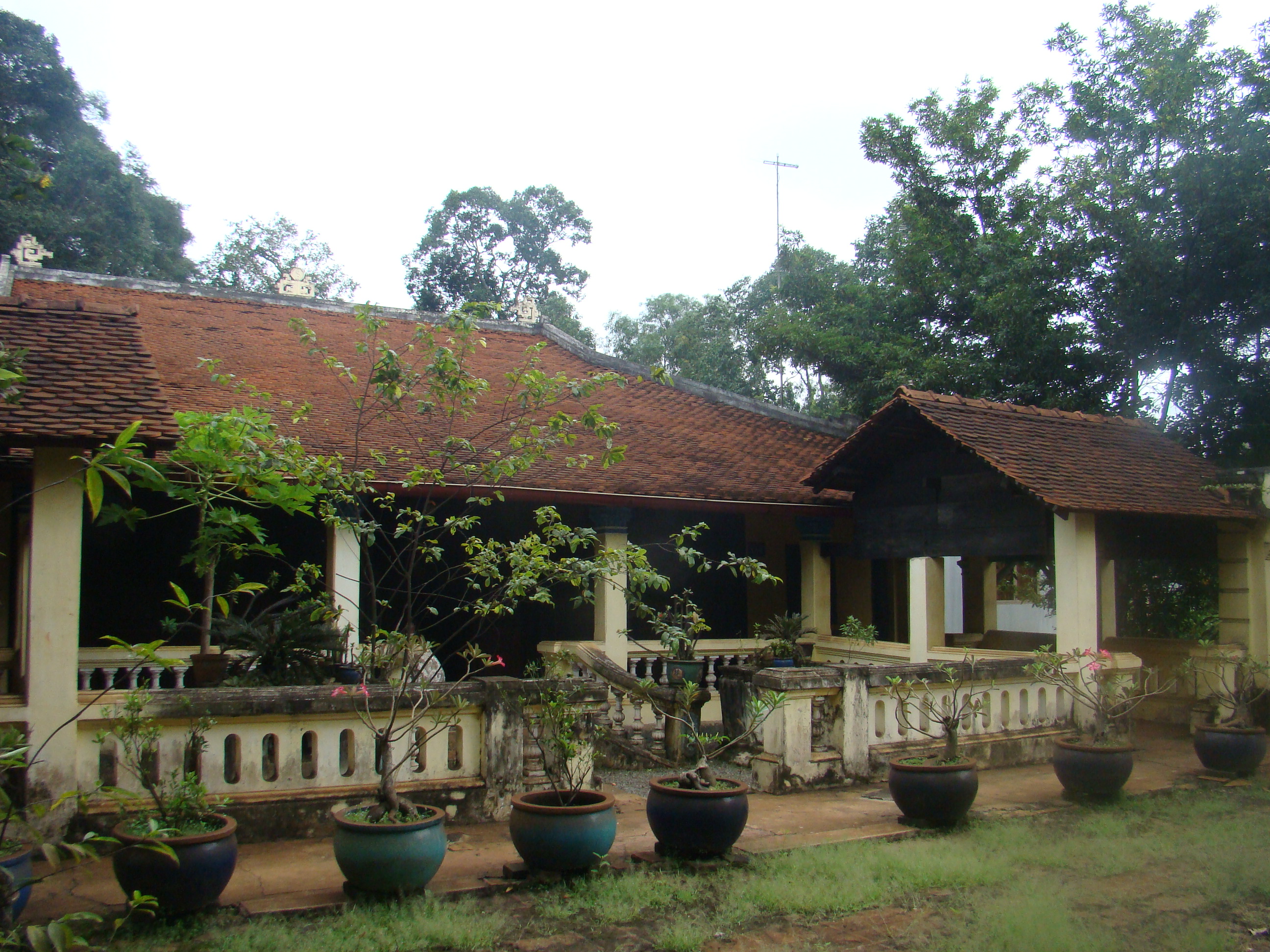
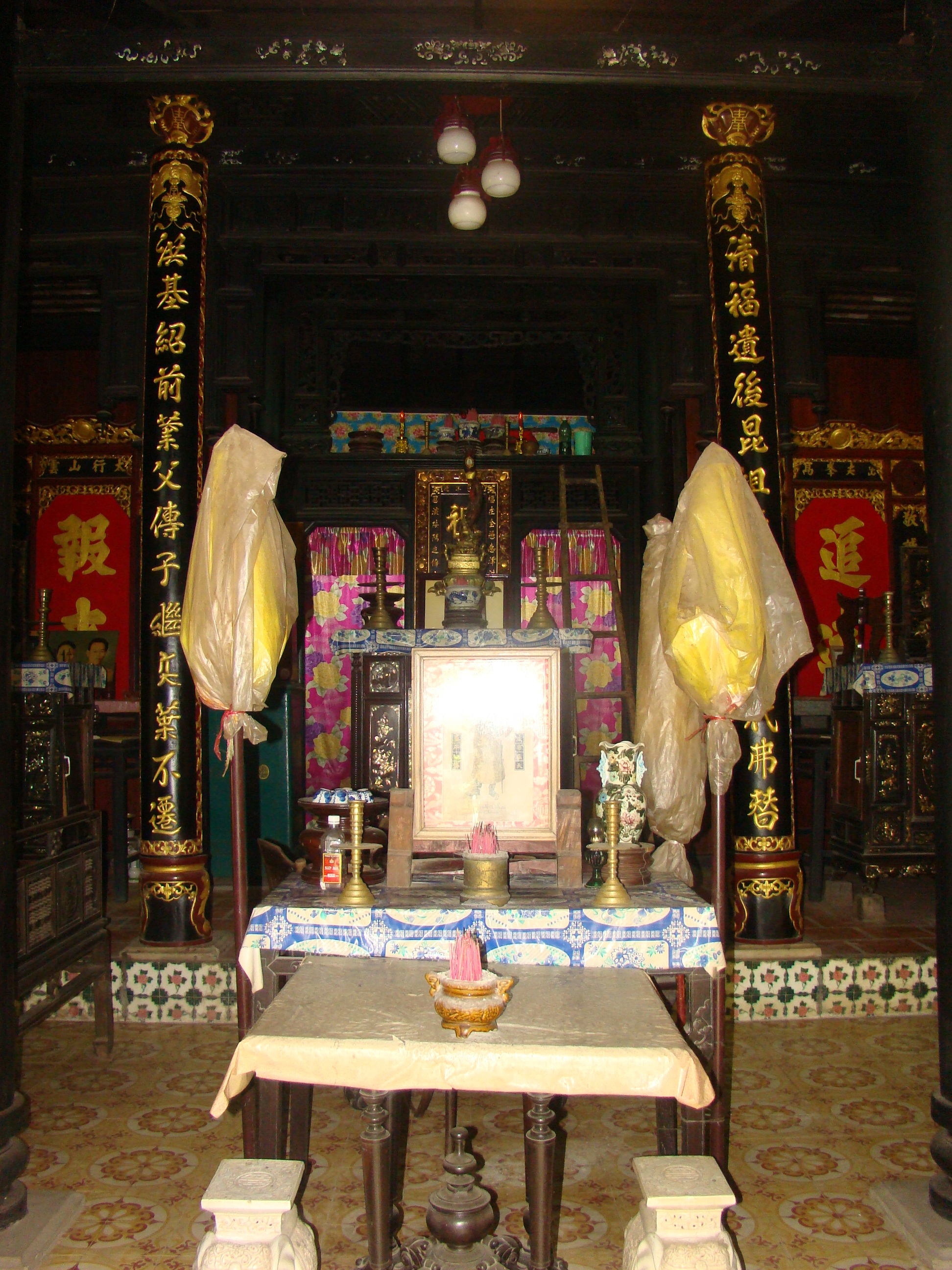
| | Do Cao Thua’s Ancient House | Historical - Culture Monuments | Bài viết | | Do Cao Thua’s Ancient House | /dautuphattrien/PublishingImages/2017-07/do-cao-thua-1404182944_Key_03072017145641.png | Located on Bach Dang Island, Binh Hung Village, Bach Dang Commune, Tan Uyen Town, Do Cao Thua Ancient Church is a provincial- level Artistic Architecture Monument architectural monument ranked on June 2nd, 2004. | 1/1/2017 3:00 PM | No | Đã ban hành | | Built around the end of nineteenth century, the ancient house Do Cao Thua is the majestic splendor in the architectural style of letter Ding in Chinese language (丁), roofed with thick double tile, ancient, vast with all made of precious and rare woods, firm with elaborately-carved patterns. Besides, there are also horizontal lacquered board, pair of wood panels, altar which were carved with stylized patterns on themes: dragon, qilin, turtle, fenghuang, deer, grape etc,. which created the unique artistic culture by skillful craftsmen. These bring Vietnamese culture in Binh Duong at that time. The house was built in a cool garden, beautiful views in the green of luxuriant fruit trees welcoming fresh winds and coolness all year round. 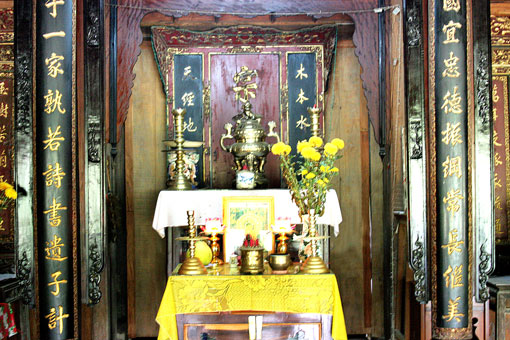
| | Phu Long Temple | Historical - Culture Monuments | Bài viết | | Phu Long Temple | /dautuphattrien/PublishingImages/2017-07/0-0aadinhphulong_Key_03072017150057.jpg | Phu Long Temple is located in Hoa Long Quarter, Lai Thieu Ward, Thuan An Town, is a National Artistic Architecture Monument ranked on December 28th, 2001. | 1/1/2017 3:00 PM | No | Đã ban hành | | The temple is located on the riverside of Saigon River, which is romantic, cool and peaceful, yet still has a unique artistic architecture and bold culture of Southern people. Phu Long Temple is not only valuable in terms of chronology but also retains the most complete features of an ancient temple. Built in 1842, facing South,Yin-Yang roof, Chinese tiled brick floor, solid cement wall. Temple is still full of three hall, East hall, Main hall, West hall With 2 rows of 10 solid timber trees. The temple also preserves a lot of jargon on the pillar, incense... all of them have sophisticated sculpture, brilliant gold lacquer painting. The pattern inside and outside the temple is the stylized dragon fish, the scene of the bowl… in particular, it is embellished with very artistic and unique ceramics. From the yard, it is possible to capture the image of old trees, followed by a gentle wave spreading over the boats. | | Hoi Khanh Pagoda | Historical - Culture Monuments | Bài viết | | Hoi Khanh Pagoda | /Style Library/LacViet/CMS2013/Images/newsdefault.jpg | Hoi Khanh Pagoda is located at No. 35, Yersin Street, PhuCuong Ward, Thu Dau Mot City as an artistic, religious construction certified as a national remain of history and culture on January 07, 1993. | 1/1/2017 11:00 AM | No | Đã ban hành | | The pagoda was constructed in 1741 of the 18th century at a foot of a hill 500 meters from Thu Dau Mot City to the East; however, it was burnt down by the French colony in 1861. By 1868, the pagoda was built on the current location of 1,211 m2. By 2007, the 27-m 7-storey tower was built to reconstruct the Buddhism event of "Tu dong tam" (the four caves of the heart) including Lam Ti Ni Garden (the garden where the Buddha was born), Bo De Dai Trang (the place where the Buddha implements Buddhism), LocUyen Garden (the place where the first Buddhism theory is born), Ta La Song Tho (the place where the Buddha enters nirvana), representing the deepest Buddhism. In 2008, the large-scale Buddhatower and statue of 22 meters highwas constructed in the land area in front of the pagoda. The ground floor is a range of housing of 64x23m used for schools and librabry. On the top floor is the Buddha in Nirvana Statue lying on 52 meters long and rising 12 meters high. This is the artistic construction of pride and honor of Buddhism in Binh Duong, inaugurated solemnly on March 30, 2010 (the lunar February 15th, 2010) celebrating 1,000 years of Thang Long - Ha Noi. Although the pagoda has undergone re-construction and innovation, it is one of the unique pagodas to retain the preliminary architecture. The prominent feature of this old pagoda is the value of history, culture, art, architecture, and remains of hundreds of years retained to today. Hoi Khanh Pagoda is considered as the model pagoda of old time in Binh Duong Province. .jpg)
The pagoda includes four major parts. The frontier hall is the major hall of preaching, constructed by 92 pillars of precious woods. The East and West corridors are arranged in connected parallel architecture patterns that are overlapped just the same as traditional old pagodas of the South. The main hall constructed by beams and pillars, wooden walls, and door curtain includes nearly 100 wooden statues of Arhants and the ten saints sculptured by jackfruit wood and galvanized. The sculpture picture of 18 Arhantsand Bodhisattva, creating artistic works created by excellent sculpture craftmen of the late 19th century including Truong Van Cang, Nguyen Van Ba, Nguyen Van Xu, Sau Nhong, Chinh Tri, etc. For interior decoration, the statue picture for worshiping is sculptured with sophisticated features including the divider sculptured with 18 Arhans in 1921 and the sculptured pannels telling "four eras" of Buddhism fixed to the two pillars of the main hall. Sophisticate altars were finished in 1925. A wooden imprinting set used for printing Buddhism documents of over 120 years old has been maintained at the pagoda. The giant bell of the pagoda was cast in 1883 and donated by Duong Van Lua as early and strong foundation of Buddhism in the locality. 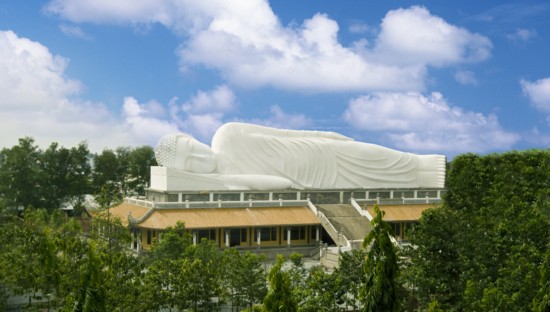
In 1923-1926, Hoi Khanh Pagoda had been hiding place for patriots who established association of honor with participation of Monk Tu Van, Doctor Nguyen Sinh Sac – the biological father of President Ho Chi Minh, Tu Cuc, and so on to encourage lifestyles of ethics, honor, and love for the people. Despite short-term existence, the association had made great impression. After August Revolution in 1945, Hoi Khanh Pagoda became a facility of Thu Dau Mot Provincial Buddhist Association of Nation Saving with plenty of devotion and sacrifices. Ever since the resistance war from 1953 to 1983, the pagoda had been a facility of local association of Buddhism. By 1995, the Song Be Provincial Basic Buddhism Study was constructed at the pagoda. Currently, senior monk Thich Hue Thong is managing the pagoda (ever since 1988) as a permanent deputy of local association of Buddhism. By May 2013, Asian Record Organization officially certified that the lying Buddhism statue of Hoi Khanh Pagoda as the longest lying Buddha in nirvana of Asia. The statue has become a part of religious lives of Vietnamese people in the course of developing Buddhism locally and nationwide. | | Southwestern tunnel of Ben Cat (The iron triangle) | Historical - Culture Monuments | Bài viết | | Southwestern tunnel of Ben Cat (The iron triangle) | /dautuphattrien/PublishingImages/2017-06/535f14d56ce86_medium_Key_27062017102722.jpg | The Southwestern tunnel of Ben Cat (the iron triangle) is located on 3 communes of An Dien, An Tay, and Phu An in the Southwestern zone of Ben Cat Town in Binh Duong Province and is 15 kilometers to the South from Thu Dau Mot City. | 1/1/2017 11:00 AM | No | Đã ban hành | | Holding a role in two resistance wars, the tunnel was ranked as national historical and cultural remain of 230,000 square meters on March 18th, 1996. 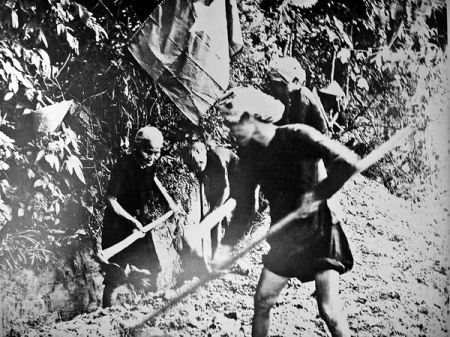
The name 'iron triangle' was familiar to many in resistance war against the US Army event though they might not have been to the place. Today, many hold many understanding of 'iron triangle'. Many believe that the place is located in Southwest of Ben Cat but many say it includes the Southwest of Ben Cat, Dau Tieng, and Long Nguyen, even wider areas from Long Nguyen of Ben Cat through Trang Bang (in Tay Ninh) and Cu Chi (in Ho Chi Minh City). They are all right regarding the locations in the 'iron triangle' through the steps of war developments. However, few may think that 'iron triangle' was originated from 3 communes of An Dien, An Tay, and Phu An. In resistance war against the French colony, the area of the 3 communes in Southwest Ben Cat was infamous of An Thanh warbase which was then the stop station of resistance war commanding headquarter of the South, special committee of Saigon, etc. to call upon locals to join revolutionary movements at the soonest in the most challenging stages of the resistance war against the US Army with sacrifices of our people. By 1948, the first underground tunnel was created in the land and then in 1960, Cu Chi guerillas followed the model to construct locally. The enemy raids again and again failed to undermine local people determination. The underground tunnel helped to evade overwhelming oversea raids of the US Army in the South, namely in 1967 with the greatest and most modern human-killing equipment in Operation Cedar Falls on January 2-21, 1967 including large-scale military forces of 30,000 soldiers, 400 tanks, 80 warships, 100 cannons, and various bombing aircrafts including B52 stratafortress; however, the complex tunnel system failed the raid, resulting in retreat of the US Army losing 3,200 soldiers, 149 tanks, 28 aircrafts, and 2 warships. Sniper Nguyen Van Duc was notorious for killing 9 by only 10 bullets or the daring venture of Vo Thi Huynh in the battle field to take care of and protect injured soldiers. In the face of continual failures, the region was named 'iron triangle'. .jpg)
The place had become a symbol of revolutionary actions and resistance wars. Using primitive tools, local people succeeded in creating a marvelous tunnel system which is unique as tons of soils had been digged up and put secretly somewhere else, showing the tight cooperation of local people and the armed forces. The auxiliary families of the zone were connected to the tunnel system to create the connection of production and fighting. The main route of the tunnel system is 4 meters underground to bear 1.2 meters high and 0.8 meter wide tunnel. In some parts of the system, the tunnel is 'constructed' with 2 up to 3 levels with secret access from above the ground. The tunnel is designed with necessary turns and ventilation holes carefully camouflaged. Around the entries are set with secret pitches, mines, and anti-tank, and anti-helicopter pitches in order to prevent enemy approach. Large basements for resting, storing foods, and hospitalizing injured soldiers are inter-connected to the tunnel. The tunnel branches connect the hamlets. Accompanied with the tunnel branches is the fighting hubs. For each 1km of a tunnel branch, 3 fighting hubs are allocated in areas of well-camouflaged pitches and mine fields. The tunnel system is nearly 100 kilometers long with about 50 fighting hubs and hiding chambers for treatment of injured soldiers and storigng of weapons and foods. The tunnel system was considered as warbase and battlefield. Major combats had been organized from such base including the Le Hong Phong Campaign in 1950, ambush, and anti-raids. The construction and re-enforcement of the tunnel system had been comprehensive in terms of politics, military, and economics. Local organizations of Party, authority, and fronts had taken good care of local people, creating unity. The tunnel system had been significant for resistance wars, especially, the stage of warding off US Army to unify the nation. In 20 years of war, the tunnel system proved to be of combat value to bury thousands of enemies and their equipment. In Spring 1968, the place helped to ward off enemies heading to Saigon, contributing to the victory of 1975. | | Phu Loi Prison relic | Historical - Culture Monuments | Bài viết | | Phu Loi Prison relic | /Style Library/LacViet/CMS2013/Images/newsdefault.jpg | Known as “Hell on Earth” with savage tortures, Phu Loi Prison was built in 1957 by the regime of Ngo Dinh Nhiem and the U.S imperialism to detain Vietnamese revolutionary soldiers. It was notorious for the poisoning of hundreds of political prisoners on December 1, 1958. The event caused the outrage of global peace lovers and Vietnamese people.
| 1/1/2017 11:00 AM | No | Đã ban hành | | Known as “Hell on Earth” with savage tortures, Phu Loi Prison was built in 1957 by the regime of Ngo Dinh Nhiem and the U.S imperialism to detain Vietnamese revolutionary soldiers. It was notorious for the poisoning of hundreds of political prisoners on December 1, 1958. The event caused the outrage of global peace lovers and Vietnamese people. With a great historical value and important political significance, Phu Loi Prison relic is developed into a place to educate about patriotic and revolutionary traditions for generations today. This is also an ideal destination for Youth Union members to organize extracurricular activities. 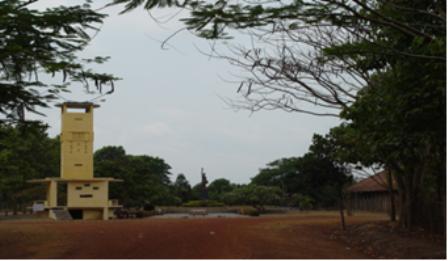
| | Binh Duong Museum | Historical - Culture Monuments | Bài viết | | Binh Duong Museum | /dautuphattrien/PublishingImages/2017-06/bao-tang-binh-duong_Key_27062017104448.jpg | Binh Duong Museum is located at No.565, Binh Duong Avenue, Hiep Thanh ward, TDM city. | 1/1/2017 11:00 AM | No | Đã ban hành | | Covering 2,000 square meters, the museum features 1,300 objects and 500 scientist documents on 8 subjects: Binh Duong's nature, Binh Duong from the prehistoric age to the 16th century, Binh Duong during the reclamation period, ethnic groups' cultural features, Binh Duong during the period of French domination, Binh Duong during the anti-French war, Binh Duong during the anti-American war, Binh Duong on the way of integration and development. The museum now stores a large volume of historical, cultural and scientific objects, comprising of a pottery collection in Rua island relic, a collection of bronze drums, Phu Chanh relic's weaving devices, a collection of bronze axes, Doc Chua relic's stone axes…Many objects on cultural ethnography like carriages, dug-out canoes, rice grinders, rice mortars…together with collections of Binh Duong's traditional crafts are also on display at the museum. Besides, there are a lot of large objects on outdoor display like helicopters, tanks, cannons… 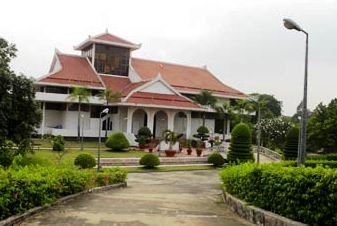
Every year, the museum receives a lot of previous objects and documents from units and individuals, making it get plentiful in terms of content. For that reason, it welcomed delegations of pupils in and out of the province over the past time. This is also seen as a cultural address for visitors to enjoy the quintessence of traditional culture of people in Binh Duong. |
|